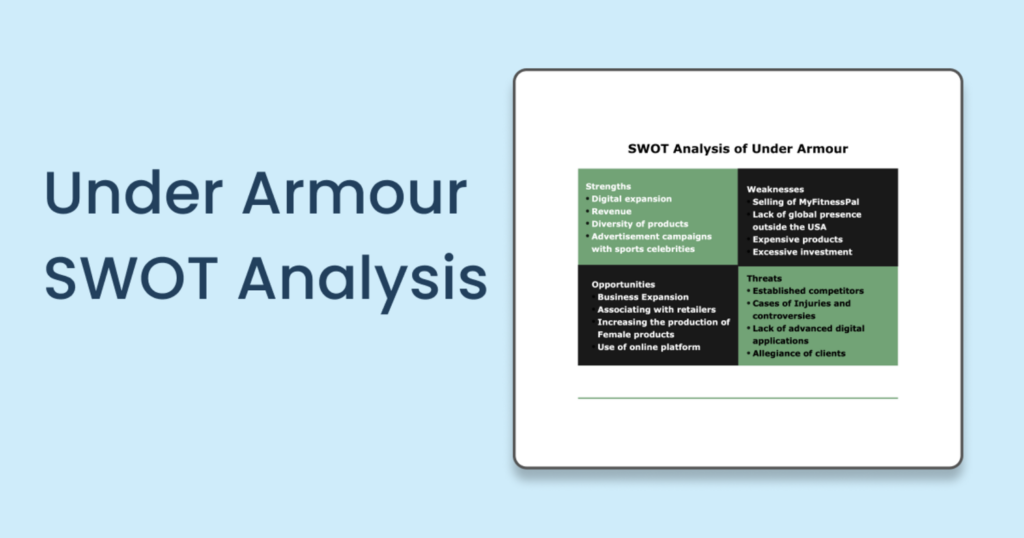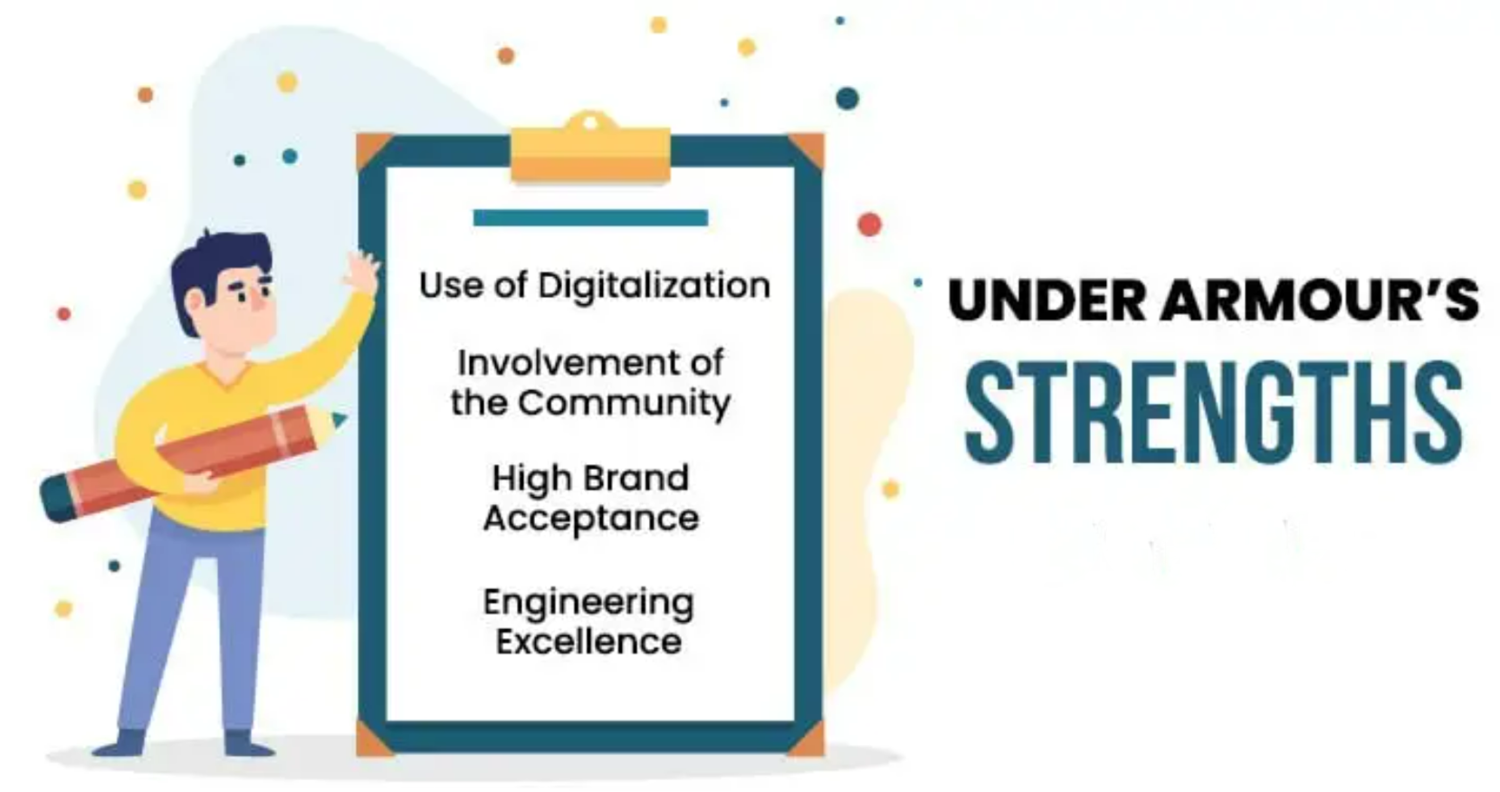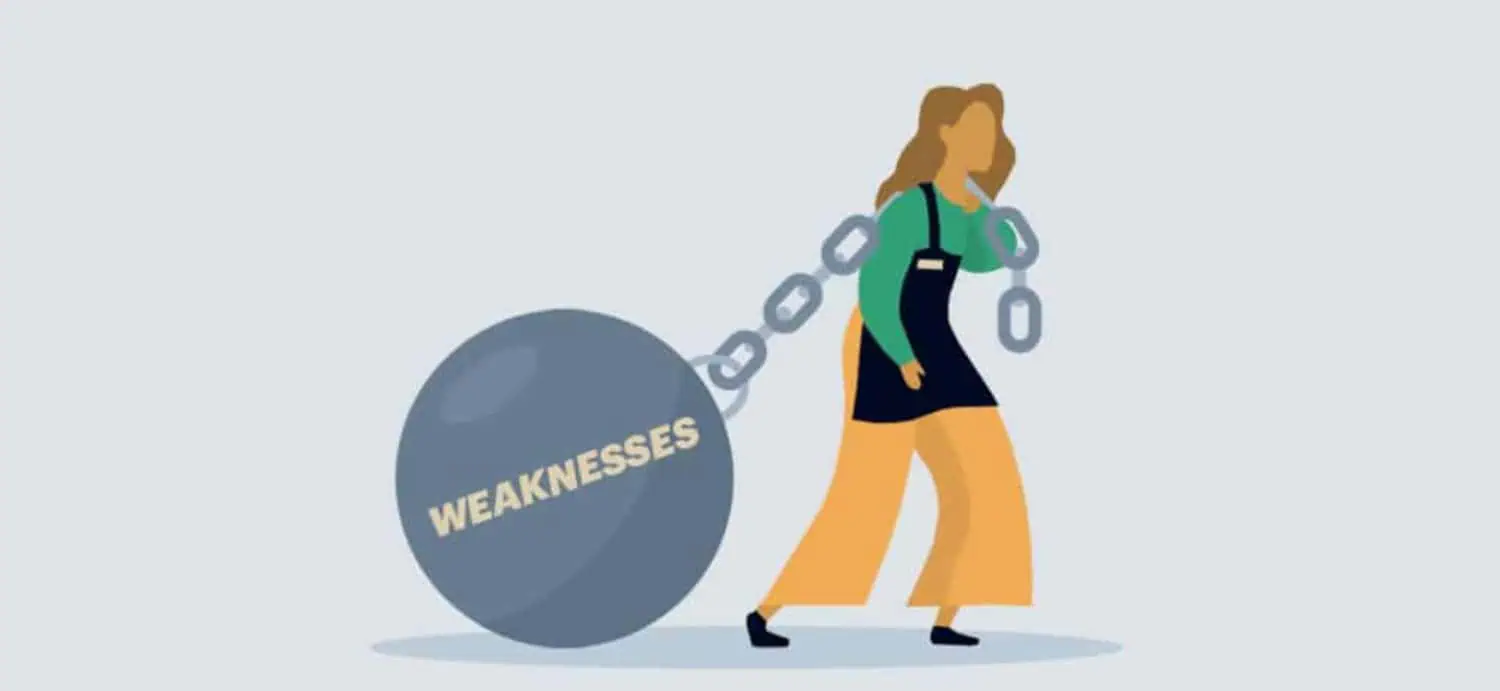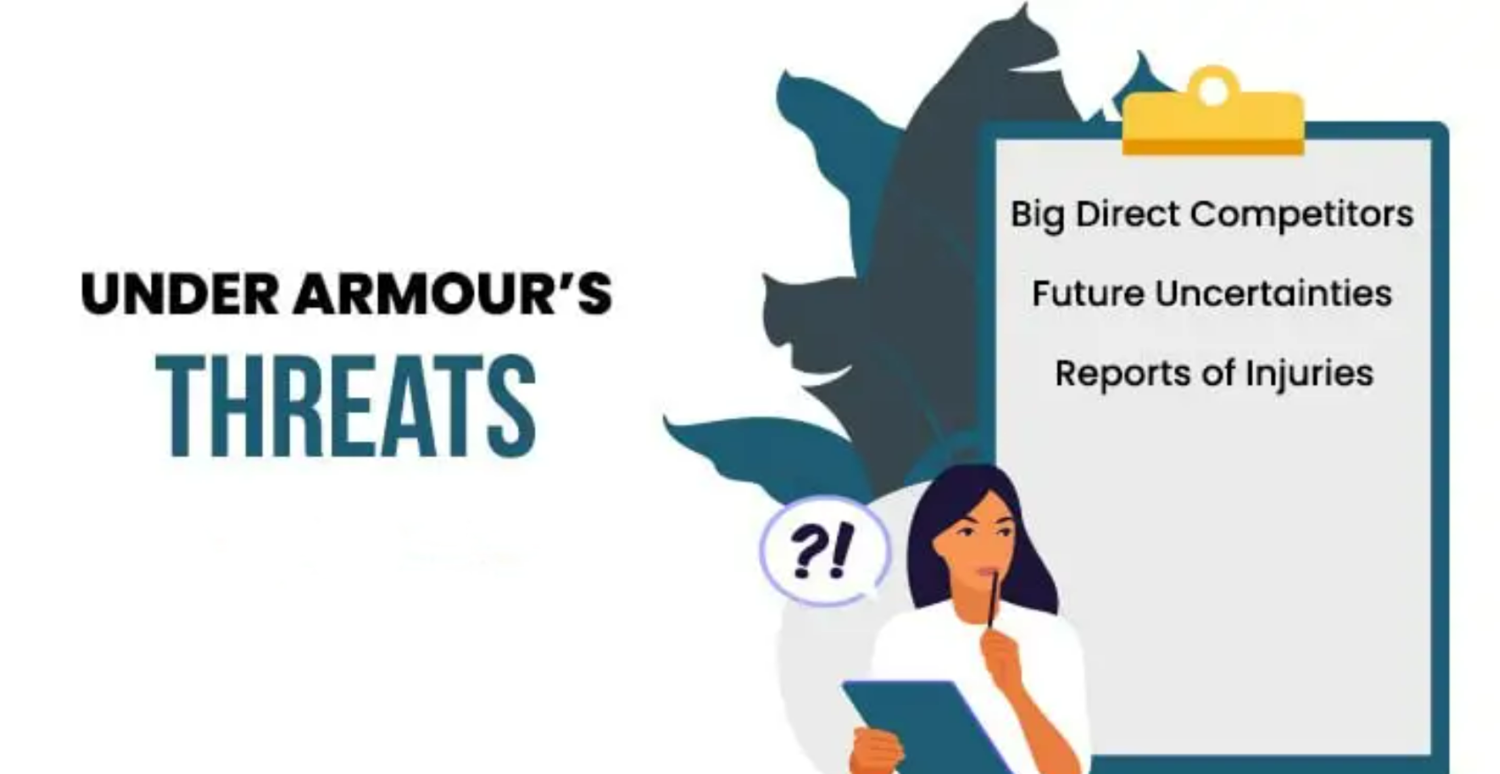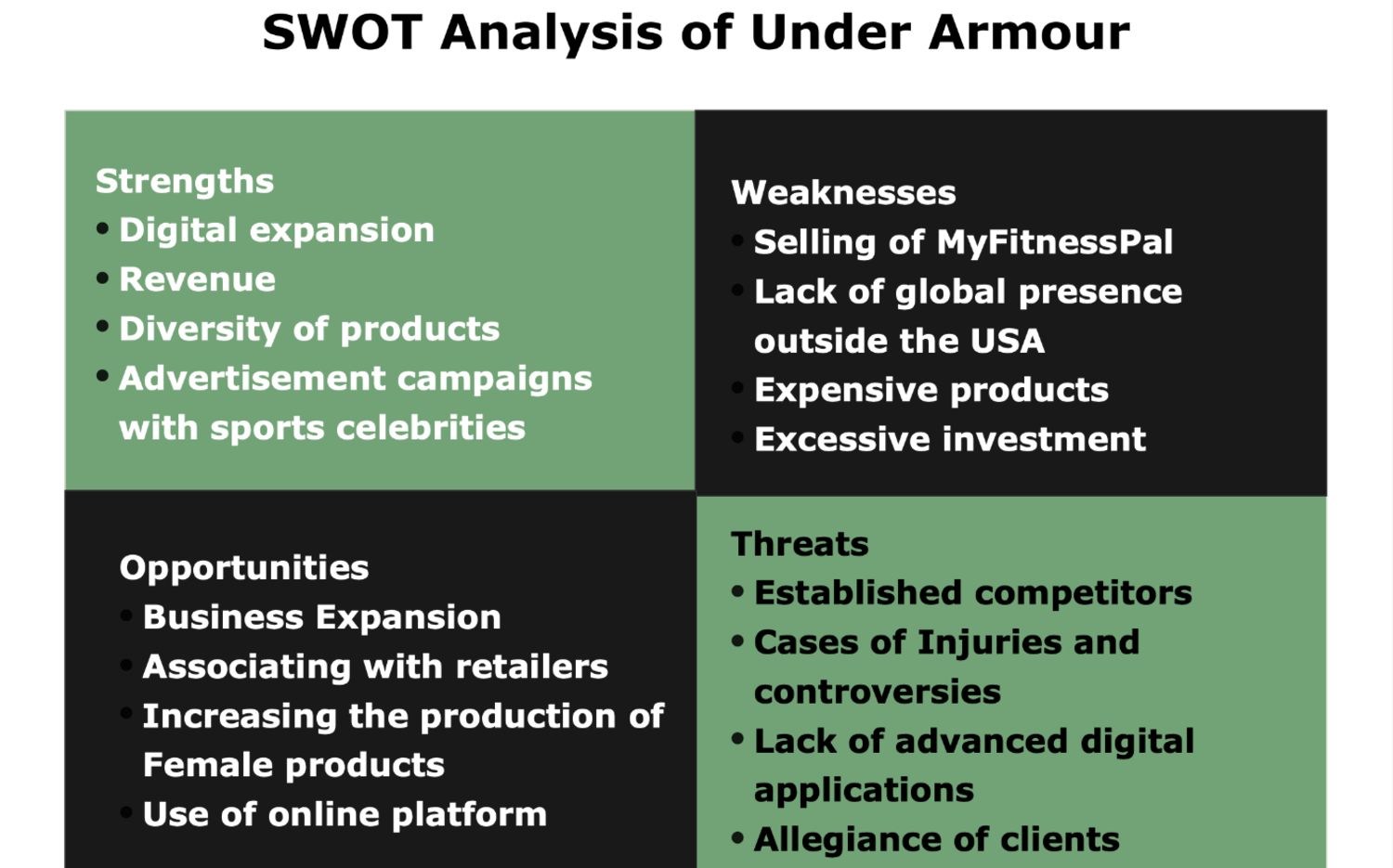Under Armor’s innovative offerings and strong brand appeal has captured athletes and fitness enthusiasts worldwide. We can understand more through a SWOT analysis of Under Armour.
By conducting a SWOT analysis of Under Armour, we can comprehensively explore its strengths, weaknesses, opportunities, and threats, gaining insights into its market standing and future potential.
Under Armour: SWOT Analysis and Key Insights
This article will explore each aspect of the SWOT analysis, shedding light on the company’s internal and external dynamics. Moreover, we will cover commonly raised inquiries to offer a comprehensive view of Under Armour’s path.
Strengths: A Foundation of Innovation and Brand Identity
Under Armour boasts several notable strengths that contribute to its competitive edge in the market. One of its most compelling strengths is its dedication to innovation.
Continuously pushing sports apparel technology’s limits, the company innovates products that elevate performance and comfort.
With innovations like moisture-wicking fabrics and cutting-edge compression gear, Under Armour leads the industry through its dedicated research and development efforts.
Moreover, the brand’s strong identity reverberates with consumers. Under Armour has effectively marketed itself as a symbol of dedication, determination, and hard work.
Sponsoring high-profile athletes and teams and impactful marketing campaigns have established a deep emotional connection with its target audience. This brand loyalty contributes to consistent sales and a devoted customer base.
See also: How to do Competitor SWOT Analysis? 101 Guide
Weaknesses: Areas of Improvement for Under Armour
While Under Armour possesses various strengths, it’s not without its weaknesses. One significant weakness is its relatively limited product diversification compared to some competitors.
The company heavily relies on its performance-oriented apparel and footwear, leaving it vulnerable to shifts in consumer preferences or market trends. A broader product portfolio could mitigate this risk and open new revenue streams.
Additionally, Under Armour has faced criticism for its pricing strategy. Consistently pushing the boundaries of sports apparel technology, the company creates products that enhance performance and comfort.
This could alienate price-sensitive customers and lead them to explore more affordable alternatives.
Read also: FedEx SWOT Analysis: Things to Learn From the Shipping Giant
Opportunities: Potential Avenues for Growth
Amidst challenges lie numerous opportunities that Under Armour can capitalize on. The growing trend of health & wellness consciousness presents a significant avenue for expansion.
The company could leverage this trend by further developing its activewear lines and positioning itself as a lifestyle brand for individuals pursuing an active and healthy lifestyle.
Furthermore, the rise of e-commerce provides an exciting opportunity for Under Armour to expand its online presence.
With the right digital marketing strategies and user-friendly online platforms, the company could tap into a broader global customer base and provide a seamless shopping experience.
Check this out: Gucci’s Marketing Strategy: How Did it Win Fashion?
Threats: Navigating the Competitive Landscape
Under Armour faces various threats in a rapidly evolving market that could impact its market share and profitability. Intense competition from established brands like Nike and Adidas poses a considerable challenge.
These giants have robust brand recognition, extensive product lines, and a global footprint, making it critical for Under Armour to innovate and differentiate itself continuously.
The unpredictable nature of fashion and consumer preferences also poses a threat. A sudden trend change might lead to excess Under Armour inventory or sales decline.
Check this out: What are the Alternatives to a SWOT Analysis?
FAQs
Is Under Armour only focused on performance-oriented apparel?
While renowned for performance gear, Under Armour is diversifying beyond its core products. It has started to expand its product range to include more lifestyle and athleisure options to cater to a broader audience.
How does Under Armour compete with industry giants like Nike?
Under Armour competes by focusing on innovation, niche marketing, and athlete endorsements. By employing a technology-driven strategy, the company sets itself apart in sportswear. Additionally, it aligns with dedicated athletes, epitomizing its values.
What steps is Under Armour taking to address its pricing perception?
Under Armour is exploring strategies to address its pricing perception. The strategy involves presenting various products at varying prices, emphasizing innovative attributes, and periodically providing promotions for greater affordability.
How is Under Armour adapting to the growth of e-commerce?
Under Armour is actively expanding its e-commerce presence. The company is enhancing online shopping, utilizing digital marketing to expand reach, and investing in tech for better customer engagement.
Conclusion
In conclusion, a comprehensive SWOT analysis of Under Armour unveils the company’s strengths, weaknesses, opportunities, and threats in the dynamic sports apparel and footwear industry.
While its dedication to innovation and strong brand identity bolsters its position, areas such as product diversification and pricing strategies warrant attention. Navigating the competitive landscape and capitalizing on trends like health consciousness and e-commerce will be crucial for Under Armour’s continued success.
As the company adapts and evolves, strategic decisions guided by this analysis could pave the way for a resilient and prosperous future.
Check this out: SWOT Analysis of Gap: Retail and Apparel Brand

